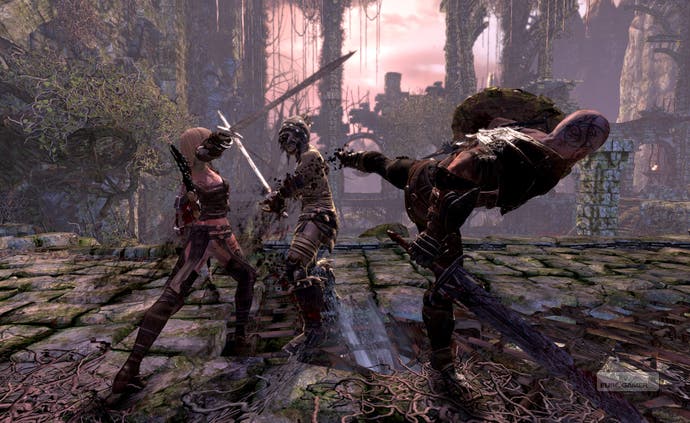Hunted: The Demon's Forge
Brian Fargo's inXile resurrects the dungeon crawler.
"We are creating a dark and gritty world, that's kind of the underlying theme," says Kaufman. "And it just gets darker and darker as you progress through," adds Findley. "Both from a story point of view and from an environment point of view... It kind of goes from messed up to really messed up."
It's foreboding, atmospheric, detailed, although the art and production design isn't going to win any prizes for originality - from the way the leather straps, scabbards and pouches of Elara's skimpy costume frame her pert backside to the crunchy sport-metal soundtrack, from the long fangs of the slavering orcs to the claustrophobic fog of the depth-of-field effects.
There is, however, an agreeably blunt, no-nonsense air to proceedings - cut-scenes are more like cut-aways, ruthlessly efficient in their exposition and hard-bitten one-liners - as if nothing should spend too long delaying the slaughter. And there's a pleasing mixture of novelty and nostalgia in seeing this absolutely straight fantasy portrayed in a style more commonly applied to concrete, railguns and butch militarism.
Fargo admits that they're not looking to rewrite the fantasy rulebook, stylistically. "The beautiful part about fantasy, traditional fantasy, is that you look at an orc and you kind of know what it does, and if a dragon comes flying over head you kind of know what it does, there's a certain sense of these things from all these years... there's a language, I guess."
Why aren't there more fantasy action games like this? "That's a very good question," Fargo says. "Early on when we very first started this project, we know Mark Rein over at Epic pretty well, and he was like, 'I don't know why everybody else isn't doing more of these.' The thing about fantasy is, it's not small, it's not a niche, right? World of Warcraft has done OK. It's one of the tent-poles." He shrugs. "I think these things just sort of come and go."

Back to the action, and we're in a cavernous barn, battling waves of orcs, with Findley and Kaufman manning the two characters. Elara snipes with her bow in almost-first-person from cover or a balcony, snapping instantly to her sights when taking refuge behind a wall. Caddoc wades into the fray, tossing shields that degrade with every hit to pick up a new one from a fallen foe.
The enemies are designed to force the two to work as a team, playing to their strengths as melee and ranged specialists. inXile is keen to point out that the game enables what it calls "co-op at a distance", allowing the characters to fight together from opposite corners of the map and avoiding mechanics that force them to be in the same place. If one falls in battle, the other doesn't have to schlep over to perform battlefield CPR - you can just aim at your companion and toss over a regenerative vial pick-up.
The same's true of the spells the pair learn; both get access to magic as the game progresses, trading crystals they find with Seraphine for new abilities at checkpoints. Caddoc learns a levitation spell that elevates enemies to make a clear target for Elara across the room, and there's a "battle charge" system of temporary buffs that can be fired at your team-mate to power them up for a difficult scrap.
"We didn't want people to feel tethered," says Fargo. "It's fun to open up the environment to use strategically." Although they're shy of coming out and saying it, this is one area where the inXile team clearly feels it's been able to improve on the prevalent mechanics in co-op action gaming.
"We've played them all extensively," says Findley of their rivals, picking his words. "What we found was a lot of weaknesses that we designed around. I'd hate to call out another product, but I think if you look at the things that we've done with the co-op design, it'll be pretty obvious which ones we didn't like." And the affable big man roars with laughter.

